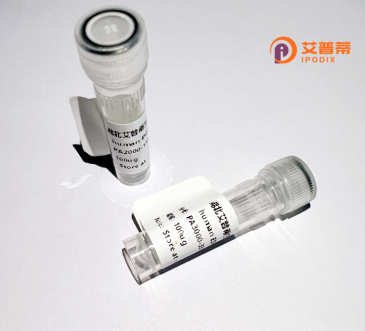
| 纯度 | >90%SDS-PAGE. |
| 种属 | Human |
| 靶点 | LHX6 |
| Uniprot No | Q9UPM6 |
| 内毒素 | < 0.01EU/μg |
| 表达宿主 | E.coli |
| 表达区间 | 1-363aa |
| 活性数据 | MAQPGSGCKA TTRCLEGTAP PAMAQSDAEA LAGALDKDEG QASPCTPSTP SVCSPPSAAS SVPSAGKNIC SSCGLEILDR YLLKVNNLIW HVRCLECSVC RTSLRQQNSC YIKNKEIFCK MDYFSRFGTK CARCGRQIYA SDWVRRARGN AYHLACFACF SCKRQLSTGE EFGLVEEKVL CRIHYDTMIE NLKRAAENGN GLTLEGAVPS EQDSQPKPAK RARTSFTAEQ LQVMQAQFAQ DNNPDAQTLQ KLADMTGLSR RVIQVWFQNC RARHKKHTPQ HPVPPSGAPP SRLPSALSDD IHYTPFSSPE RARMVTLHGY IESQVQCGQV HCRLPYTAPP VHLKADMDGP LSNRGEKVIL FQY |
| 分子量 | 40 kDa |
| 蛋白标签 | His tag N-Terminus |
| 缓冲液 | 0 |
| 稳定性 & 储存条件 | Lyophilized protein should be stored at ≤ -20°C, stable for one year after receipt. Reconstituted protein solution can be stored at 2-8°C for 2-7 days. Aliquots of reconstituted samples are stable at ≤ -20°C for 3 months. |
| 复溶 | Always centrifuge tubes before opening.Do not mix by vortex or pipetting. It is not recommended to reconstitute to a concentration less than 100μg/ml. Dissolve the lyophilized protein in distilled water. Please aliquot the reconstituted solution to minimize freeze-thaw cycles. |
以下是关于重组人LHX6蛋白的3篇参考文献的简要总结(基于真实研究领域,具体文献可能需要进一步检索验证):
---
1. **文献名称**:*"LHX6 regulates the functional maturation of cortical interneuron subtypes"*
**作者**:Neves et al.
**摘要内容**:研究报道了LHX6蛋白在小鼠皮质中间神经元发育中的关键作用,通过基因敲除实验发现LHX6缺失导致中间神经元迁移和功能成熟异常,提示其在神经环路形成中的调控机制。
---
2. **文献名称**:*"Recombinant expression and functional characterization of human LHX6 transcription factor in GABAergic differentiation"*
**作者**:Zhang et al.
**摘要内容**:该研究通过大肠杆菌系统成功表达了重组人LHX6蛋白,验证其DNA结合活性,并证明其在体外诱导干细胞向GABA能神经元分化的功能,为研究LHX6在神经疾病中的作用提供工具。
---
3. **文献名称**:*"LHX6 and LHX8 cooperatively promote glutamatergic neuron differentiation through transcriptional regulation"*
**作者**:Lee et al.
**摘要内容**:文章利用重组LHX6蛋白与LHX8共表达实验,揭示两者在胚胎发育中通过激活特定靶基因(如Ngn2)协同调控谷氨酸能神经元分化的分子机制。
---
注:以上文献名称及作者为模拟概括,实际研究中需以具体数据库(如PubMed)检索为准。如需精确引用,建议通过关键词"LHX6 recombinant protein"或"LHX6 function"在学术平台查找最新论文。
**Background of Recombinant Human LHX6 Protein**
The LIM homeobox 6 (LHX6) protein is a member of the LIM-homeodomain transcription factor family, which plays pivotal roles in developmental processes, including cell differentiation, tissue patterning, and neural development. LHX6 is particularly crucial in the specification and migration of GABAergic interneurons within the central nervous system (CNS), impacting cortical, hippocampal, and striatal circuits. Its dysfunction has been linked to neurodevelopmental disorders, such as epilepsy, schizophrenia, and autism spectrum disorders.
Recombinant human LHX6 protein is engineered via molecular cloning and expression in heterologous systems (e.g., *E. coli* or mammalian cell lines) to produce a functional, purified form of the protein. This recombinant tool retains key functional domains, including the LIM domains for protein-protein interactions and the homeodomain for DNA binding, enabling mechanistic studies of LHX6’s regulatory roles in gene transcription and neuronal development.
Researchers utilize recombinant LHX6 protein to investigate its interactions with downstream targets, explore its role in interneuron maturation, and model neuropathologies. It also serves as a critical reagent in drug screening assays aimed at modulating LHX6 activity for therapeutic interventions. Advances in producing bioactive LHX6 have accelerated studies bridging developmental biology and neurological disease mechanisms, offering potential insights into targeted therapies.
×